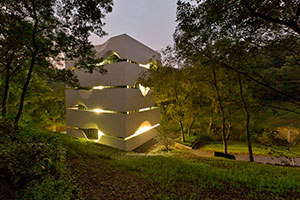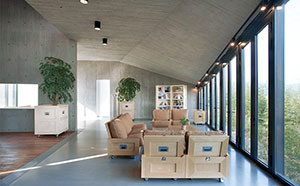China’s design playground gives world’s top architects free rein
Simply sign up to the Life & Arts myFT Digest -- delivered directly to your inbox.
When the Pritzker Prize-winning architect Wang Shu was asked to build a villa by an ambitious Chinese property tycoon he was given a simple spec. The house must have at least five bedrooms and span 500 sq metres. Other than that, Wang was free to make whatever he wanted, with whatever materials, at whatever cost.
His villa, one of 20 holiday homes in an architecture park nestled in a wooded valley outside the former imperial capital of Nanjing, is built with Terrazzo brick. But this particular brick was only produced in one place: a small village next to the garden city of Suzhou. As such, 10 villagers were shipped to the park for the duration of the construction period to install the bricks on site.
The result is a spectacular ode to traditional Chinese architecture. The San-He Residence, as Wang’s villa is called, sits under a graciously curved roof reminiscent of a temple. Colossal rooms surround an inner courtyard with a shallow rectangular pond upon which pink water lilies grow. Nature is carefully harnessed: a single tree sits at one end of the pond; another bursts from a hole in the roof out into the sky.
Over the past decade, real estate developer Lu Jun has spent $164m of his own money building the park alongside a major new private art museum. The complex, which opened last November, is at the cutting edge of design. Architects involved in the project, which features a hotel and conference centre as well as the villas, include Briton David Adjaye, Japan’s Arata Isozaki and the Chinese artist-dissident Ai Weiwei.
On top of the hill sits the ethereal Sifang Art Museum. Its upper galley is a white diaphanous box resting on columns 30ft above ground, giving the impression that the structure is levitating, particularly at dusk when it emits an incandescent glow. Built by New York architect Steven Holl, it is a triumph of light and form.

China’s economic boom, rapid urbanisation, and a desire among the country’s billionaires to leave a legacy, has created space for the kind of experimental architecture that is increasingly rare in cash-strapped Europe and the US. The “collecting” of star architects together in a high-profile complex is nothing new. Within the context of one of the fastest growing economies in the world, however, it comes with increased force and verve. “It is evidence of this enormous impulse to experiment and to try different things,” says Aric Chen, curator of architecture and design at the M+ museum in Hong Kong. “It is really indicative of this hunger for variety and for seeing what is possible.”
In Nanjing, the art museum’s garden walls are made of black concrete: the wall’s rugged texture, imprinted with the grooves of bamboo, was created by pouring concrete slush into halved bamboo shoots which originally grew on the site. In many of the buildings, including Holl’s, the architects required exposed concrete. Lu sent a team of people to study the technique in Japan.
“It’s a lot of trailblazing – a lot of things are new and novel to us,” says Lu Jun’s 30-year-old son Lu Xun, who manages the project with his father. “We had to create and improvise.”
Just 20 years ago there were no private architectural firms in China, only state-run institutes. Today, the construction boom has gone hand-in-hand with colossal rural-to-urban migration. Whole cities have emerged from the dust, made up of cheap, monotonous high-rises.
The Lu’s vision was not so frenzied. “As profit-orientated developers quickly changed the landscape of Chinese cities by building repetitive architecture at minimal cost, we felt obliged to do something different, to ‘break the mold [sic]’ and inject a new architectural and artistic breath,” their manifesto reads.
Crucial is a contemporary Chinese aesthetic and many designs draw on local traditions. Zhang Lei’s Blockhouse villa has an austere concrete, pagoda-like façade with sculptural windows which act like a Chinese landscape painting, providing set points of view through which the audience can admire the vista. When sitting on the roof terrace, hemmed in by the dense forest, “you get a similar feeling [to] a Chinese courtyard house”, says Zhang, referring to traditional architecture in which rooms surround an inner open air space.
Foreign architects have also taken up the baton. At first glance Holl’s museum is giddily futuristic. Twisting shapes have long been a trademark of his work. Its play on perspectives, however, fits seamlessly into Chinese ideas of beauty. Inside, the winding corridors allow for constantly shifting viewpoints reminiscent of a Suzhou garden. “Every corner you turn you see a different perspective, every wall is oblique, every space gives you a different experience,” says Lu. History is be found in the details. Old bricks from demolished courtyard houses in Nanjing, for example, have been used to pave the outside of the gallery.
Construction has not been without challenges. First conceived in 2002, the 115-acre park has already taken a decade to open and many villas remain unfinished, weeds creeping up their ghostly frames. (A further three villas, according to Lu, will be completed this year.) Whether people will visit the art museum or rent the villas, and whether they will be properly maintained remains to be seen.

More immediately, practicality is often sacrificed for dramatics. Fo-Shou, a villa by Luis M Mansilla and Emilio Tuñón, is shaped like a deformed funnel with walls made entirely from glass surrounded by a screen of bamboo. Inside, you are at once hemmed in and utterly exposed. Sleeping there might feel like spending a night behind bars.
For Ai Weiwei’s Six-Room, functionality was critical. “First, it’s a vacation house or a house with no owner. So it gives you some liberty and some impossibilities,” he says, speaking from his studio in Beijing. “You don’t know who you design for. You have to use a language which doesn’t reflect just one thing, which is more abstract, not just one taste.” In his villa, six rooms stand in a stark row, decked with pack-up-and-go furniture created from crates. Unlike other architects, Ai improvised with materials already available and kept the budget low (the building is made from a concrete frame commonly used in China). He describes designing “like a game. [With limited resources] you see more performance and every move has to be relevant.”
Yet the mixture of art and commercial space (Lu Jun is now building a high-end residential development next to the museum) has led to questioning over motives. In China, museums can be used as a ploy to get better land deals from the government. Chen, for one, is unconcerned. “Building has to be commercially viable and I would much rather see developers building things that advance architecture than simply putting up another cluster of generic boxes or towers,” he says.
For Lu Xun, an earnest young man who speaks immaculate English, there is little doubt about his love for architecture. “Any [art] exhibition that we have curated for the past two months becomes weak when compared to this grand complex that we have been working on for the past ten years,” he says. Looking out over the valley, where architectural gems glint among the trees, it is hard to disagree.
——————————————-
Horizontal Skyscraper – Vanke Centre, Shenzhen, Steven Holl (2009)
Steven Holl’s website says that the Horizontal Skyscraper located in the southern Chinese boomtown of Shenzhen is “as long as the Empire State Building is tall”. Standing on eight legs, the structure appears to float above ground. Vistas of the tropical gardens below can be seen via glass cubes. The building, which houses the headquarters of Vanke Co Ltd, as well as apartments, restaurants and cafés, not only looks good, but is safety-conscious too, both tsunami-proof and extremely green.
Commune by the Great Wall, Beijing (2002)
Like the Nanjing architecture park, Commune by the Great Wall is a collection of villas designed by star architects that are available for rent, except in this case the architects are all Asian. Set in motion by the billionaire husband-and-wife team Pan Shiyi and Zhang Xin of SOHO China, the largest real estate developer in Beijing (the pair were also behind Zaha Hadid’s Galaxy Soho), it was first exhibited at the 2002 Venice Biennale. Notable designs include “Bamboo Wall” by Japan’s Kengo Kuma and “Suitcase House” by Hong Kong’s Gary Chang. Beijing is full of Soviet-style buildings; Commune’s architecture offers a welcome respite.
Galaxy Soho, Zaha Hadid, Beijing (2012)
From the congested highway in downtown Beijing, the gleaming white Galaxy Soho appears like something from outer space. The vast structure (it stands at 332,857 sq metres) is made up of interconnecting curved pebbles linked by sky-bridges. It is a voluptuous, romantic building that stands in stark contrast to the drab high-rises that surround it. In China, where there is a strong preference for curvaceous forms that evoke natural formations like mountains and stones, the British-Iraqi architect Zaha Hadid is a hit.
Comments